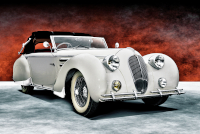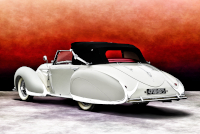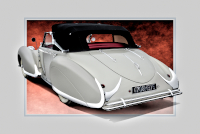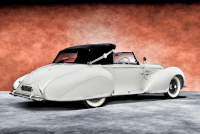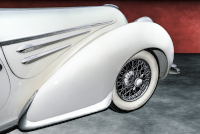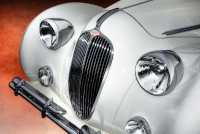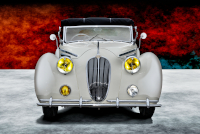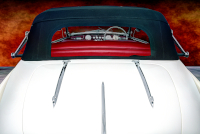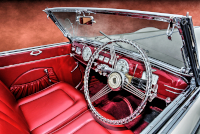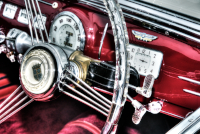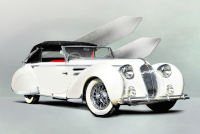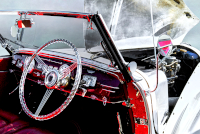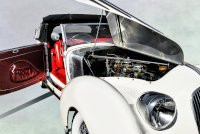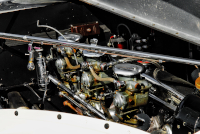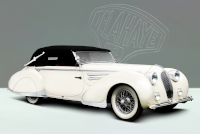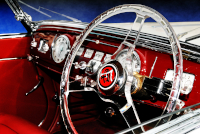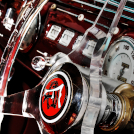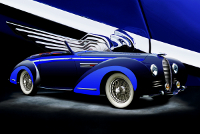Location:
St. Michaels Concours d'Elegance, 2023
St. Michaels Concours d'Elegance, 2012
Radnor Hunt Concours d'Elegance, 2011
Owner: Ed & Carroll Windfelder | Baltimore, Maryland
Prologue:
Special thanks to Mr. Ed Windfelder, who has been quite enjoyable to talk to.
Our main illustrations stem from the 2023 St. Michaels Concours d'Elegance, recently held not at St. Michaels but on Kent Island.
The 2023 event holds the distinction of occurring in the wake of Hurricane Ophelia, which flooded the island and sequestered a few brave entrants to the wharf along the main drive. After an hour or two, the storm surge overtook the grounds and the Chesapeake coursed beneath the cars, this Delahaye included. Consider that for the cabin illustration above (15), the entire surrounding landscape was in fact water, no dry land to be found from the pavement south from Kent Narrows to Prospect Bay. Mini Mokes plowed through the water until the level became too high, three to four feet in lowland areas, and the show cars evacuated the wharf.
Also in 2023, Richard Adatto completed a wonderful survey of Figoni coachwork on the Delahaye 135 and 145 platforms, including chassis #800998. Published by Dalton Watson, the volume includes photographs by Michael Furman with predictably glossy results. To see this car in print so recently is all the more reason to deliver an appropriately glamorous profile, and not in the least because I've always felt I did not do justice to the design with my old material.
We first saw #800998 in 2006, just following its restoration by Old York Classics, and we've since seen the car at many east coast shows dating back to the now-defunct York event. That would have been a short while before the car traveled across the country to Pebble Beach. So you could say this Delahaye is a regional celebrity. But more remarkably, the Windfelder's Delahaye looks as clean and crisp today as it did 15 years ago fresh out of the shop.
I also learned a lot while photographing this car, proved by the number of failed shots I accumulated. But opportunity pays dividends, which brings together this new set of illustrations. The car deserves proper exhibition, and I now feel that with this profile we're approaching top-shelf status among the richest of Figoni designs.
- - - - - - - - - -
► Image Source 1-18: Nikon D750 (24.3 MP) photographed in 2023 | Image Source 19-25: Nikon D200 (10.2 MP)
Images 19 through 22 date to the 2012 St. Michaels Concours d'Elegance. Images 23 through 25 date to the 2011 Radnor Hunt Concours d'Elegance.
References:
- Mr. Ed Windfelder, owner, conversation and written correspondence.
- Adatto, Richard, "Figoni on Delahaye" Dalton Watson Fine Books, Deerfield, IL. 2023, page 249, 250, 252
- Automobile Quarterly, Volume 19, Number 3, Third Quarter 1981, "His Highness' Delectable Delahaye... A Tour de Force from Carrossier Franay" by Ken Gross, The Kutztown Publishing Company, Inc., Kutztown, PA, page 230-231
- Wikipedia, Mohammed Ben Aarafa: Source for the referenced photograph of El Glaoui and Ben Aarafa together in the original Delahaye of this type.
- Wikipedia, Thami El Glaoui: Information on the patron whose namesake defines the Figoni et Falaschi body style.
- Mail & Guardian: "Cashing in on Congo," Chris McGreal, February 13, 1998
As a Baltimore native with New England roots, I appreciate the story of how Ed Windfelder drove #800998 from Gardner, Massachusetts down to Baltimore, doing so with the motor running for the entire trip to avoid jump starts. He purchased the car back in 1971 and roughly 20 years later personally began its first restoration.
Adatto notes that Mr. Windfelder found die-stamped Figoni et Falaschi build numbers on every piece of chrome trim, inked numbers on the wood interior trim, and acid-etched numbers on the aluminum wheel spats. Parts identification matters in the refurbishment process, but also speaks to Figoni's pride of workmanship. The more parts numbered with the coachwork build (#1053), the more the car becomes a product of Figoni et Falaschi, independent of its mechanicals.
Politics and Posture: The Story behind the El Glaoui Name
We do not use the name 'El Glaoui' lightly. The style of Figoni et Falaschi body that led to a series of 18 examples originated in a commission for T'hami El Galoui Pasha of Marrakesh, a central figure in the story of France's influence in 20th century Morocco. T'hami eventually led a coup d'etat against Sultan Sidi Mohammed ben Yusef (Mohammed V) in May of 1953, installing Mohammed Ben Aarafa in his place. It is in fact a photograph of Ben Aarafa and T'hami El Glaoui in which we see the Delahaye in question, as the two sit in close conversation together in the back seat. We therefore find a striking connection between French style as an export and European interests in northern Africa. In this case, a gem-like Delahaye rolling through Marrakesh represents French sympathies under political influence—a soft-power symbol.
Not to belabor the squeamish subject of politics, (and it is a strange thing to say), but the Delahaye 135 model survived in the post-War era exactly for this purpose. Technology having progressed and the world having moved on, classic era styling would have appealed to those looking to evoke a mythical sense of wealth, as if having been borne from Versailles.
The photograph noted above should be dated sometime in the early to mid-1950s, though it seems two decades older. This is only to say that a 1948 Delahaye is obsolete, and forcefully so. Delahaye were not simply making do with what remained of pre-War parts; they put these same parts to the same use as before, and French coachbuilders glorified them. This process contrasts the Italian post-War trajectory, which led the industry in modern design thinking. So, whereas Chapron and Figoni sustained classic era pretenses, Touring and Pinin Farina innovated.
Automobile Quarterly comments along similar lines. In 1981, Ken Gross discussed post-War French coachwork through a conversation with Strother MacMinn, industrial design consultant and faculty member at the Art Center College of Design.
"'I spoke once with Monsieur Figoni,' MacMinn continued, 'who told me that he always liked the streamline—and as he talked about the shape, his arm traced a sine curve in the air. A highly skilled woodworker, Figoni had a tactile appreciation of how form shapes function—and his sweeping pre-War efforts made a unique statement. Without criticizing post-War designs,' MacMinn concluded, 'let's just say that some of the essential purity had been lost. There were still elements, vestiges of former grace, but the statement, for a long while into the early fifties, would remain compromised.'"
Ironically, the context for this commentary is AQ's salon profile of the 1950 Delahaye 180 Custom Convertible that Franay designed for Sidi Mohammed ben Yusef after he returned from exile and claimed the title of King of Morocco in August of 1957. By this point, T'hami El Glaoui renounced his support of the French protectorate and rallied to the sultan.
So, while meddling in Moroccan politics, the French managed to provide both sides of a coup d'état with a coachbuilt Delahaye, first for the leader of the coup, and then for the returning sultan. In this sense, France's coachwork legacy endured, whereas French foreign policy did not.
A Story of Title: French Posture in Mid-Century Manhattan
While El Glaoui Pasha did not own this particular car, a glance at its owner history turns us in an unexpected direction: one Marquis Bernard-Alexis Poisson de Menars, Prince de Bourbon-Vendôme.
The title sounds presumptuous, perhaps out-of-place for mid-century Manhattan, much as this Delahaye would have been when brought to the US from France. The car ventured stateside via a classics broker north of the city near the Tappan Zee, whence it had been under the ownership of Club Delahaye in France. The first owner in the US became the marquis, but without first-hand knowledge to validate his credentials, at the very least they seem dubious.
This part of the story is sensitive, not to disparage the artefact on the basis of one who claimed it as a possession. But the reason I tread into this territory is because these sorts of references tend to repeat; they are the cocktail party factoids that appear in concours programs that others then propagate without any validation.
So a marquis once owned Delahaye #800998, perhaps, but certainly a Manhattan socialite of pretention and not entirely immodest means. His role in history elicits topics as diverse as rent control exploitation in New York City and the attempted extortion of money from nascent African governments. At least Mr. Windfelder chuckles when discussing who the marquis was or might have been, noting that he certainly ran in fast company and attended fêtes hosted by those who were indeed verified royalty. But we make no claims as to the person who was Bernard-Alexis Poisson de Menars, or the benevolence of his intentions.
Perhaps the most notable story of the marquis appears in a South African newspaper from February of 1998. The story recounts that the marquis approached a Congolese politician in a ploy to secure a line of credit under the pretense of building a health system in the fledgling DRC. The author writes, "The 'marquis’s' credentials appeared impressive, if a little bizarre. In a letter to Mawampanga he described himself as a 'generalist and humanitarian,' a theoretician in biology and astrophysics, and an expert on the administration of large-scale, non-polluting industrial waste-disposal systems." The Mawampanga in question is a real politician and former DRC finance minister; according to the article, he declined the Marquis' offer to help.
These notes serve to point out that an impressive name attached to an impressive automobile is not always what it seems. In some sense we expect a car as fantastic as this Delahaye to be the personal conveyance of royalty, so we indulge the story. The more impressive the name, the greater the legend.
Motor: 3,557 cc straight 6-cylinder, cast-iron block and hemi-head | 84 mm x 107 mm | 7.0:1 compression
Valvetrain: OHV, 2 valves per cylinder
Aspiration: triple Solex 40 PAI carburetors
Power: about 125 bhp @ 4,000 rpm
Drivetrain: Wilson 4-speed epicyclic preselector gearbox, rear-wheel drive
Front Suspension: transverse semi-elliptic leaf springs with top links, and transverse Rafex friction dampers
Rear Suspension: live axle with quarter-elliptic leaf springs and transverse Rafex friction dampers
Architecture: steel ladder frame chassis with coachwork by Figoni et Falaschi
Wheelbase: 2,950 mm (116.1 inches)
Etymology:
The Delahaye 135 is a sporting derivative of the well-to-do 138 Superluxe. The 'M' designation stands for 'modifié.' The Figoni et Falaschi body style is formally a three-position cabriolet, (or drophead coupe in the English vernacular). However, the term 'El Glaoui' came to define the style based on its original purchaser, T'hami El Glaoui Pasha. Figoni et Falaschi also produced a similar style, termed the 'Milord' (my lord) cabriolet.
Figures:
Delahaye produced some 2,000 Model 135 cars from 1935 to 1954, with the War intervening. Of these, 18 carried the Figoni et Falaschi El Glaoui coachwork, proving the design to be reasonably popular. Of those 18, Adotto notes that ten exist today.
Each El Glaoui example is slightly different, though #800998 is particularly noteworthy as the only car of the style with partially recessed headlamps.
3-Position Anachronism: Post-War Translation of the Classic Era Convertible
The top can be placed in open-drive configuration, closed configuration, or in fully open configuration as shown in the photograph of T'hami El Glaoui and Mohammed Ben Aarafa together in the back seat of the first Delahaye to wear this coachwork. In this regard, the large chrome cabriolet arms are more than vestigial classic era components.
The method itself is obsolete, as the post-War convertible take-over sees power retractable tops replace the conventional cabriolet. So this three-position drophead design is a stubborn crusade for lost riches in the late 1940s. Absolutely lovely, but even upon its inception the design belonged to the past. Figoni produced visionary concepts and demonstrated a limitless sense of cleverness and fancy, yet the El Glaoui appears to toy with classic themes to produce a work that is not itself avant-garde, but instead reminds us of the institutional definition.
In the late 1940s, this design appeals to exclusive clientele. While in some ways I want to view the El Glaoui Cabriolet as an ostentatious precursor to the Buick Skylark that debuts five years later, economic class is another matter. The concept is roughly the same, but the Delahaye is a privileged affair whereas the Buick is a populist leader. Buick Skylark convertibles don't get involved in messy international politics, but this Delahaye certainly did.
Vaunted Elegance: Post-War Figoni Classicism Compared to American Modernism
By 1950, the grand coachbuilt style could be described as old-French, an extension of classic era practice. These are the last of the great French automobiles, a few years removed from the point at which French tax laws will bury its automotive industry. But viewed from any subsequent point in history, the lines are Rubenesque and quite pleasant on their own.
The leading edge of the fenders and nose form one of the best-proportioned fascia among French designs. The curves capture a balance comparable to the nearly perfect Lincoln Continental, soft and delicate, whereas the Lincoln is actually the more avant-garde design in this case. Henri Chapron used similar proportions, raising the height of the fenders and blossoming the front valance to create flowing curves that give the fascia a full-bodied feel without disrupting the slim aspect of the nose. Apart from Lincoln, a design that proposes this concept in a much closer, and earlier incarnation is the Hudson Terraplane.
El Glaoui: Establishing the Design Theme
Of the ten surviving El Glaoui cars, #800998—or Figoni et Falaschi build #1053—is the only one to use partially recessed headlamps. The remainder use a fully integrated headlamp design that may be more progressive, but flattens the fascia. These cars look very similar to the Talbot-Lago T26 Record, with the lights set slightly lower. Build #1053 presents an entirely different approach—again, a bit more Terraplane—and the light arrangement is an extremely rare feature.
The flanks wear a thin belt that ends in an inverted empennage at the hips, and a pair of chrome spears echo that windswept linearity on the bonnet sides. A visual foundation, the skirts and rockers wear chrome braces. These braces sweep up the back edges of both front and rear skirts, mirroring the wishbone shape of the chrome plates at the rear corners.
Purely sculptural, the rear deck is perhaps where Figoni exercises his creativity and establishes the theme for build #1053. The spade-shaped rear hatch is commonplace for the El Glaoui, but not the chrome wishbones and flush tail lights. These features distinguish build #1053 among its siblings.
Inside, the Lucite steering wheel, shift selector, and direction knobs trend toward automotive jewelry. So many of the car's accents are charming on their own, and together they deliver a loud statement. This conglomerate approach of adding elegance to the elegant defines Figoni et Falaschi coachwork. But the cleverness of Figoni is that if any of these decorations were out of place, or if the proportions weren't able to carry the decoration, then the design would fail. But all of the decorations and curves and measures work together.
Guiding Hands: Crafting a New Lucite Steeing Wheel
Acrylic steering wheels of coachbuilt Delahayes are artefacts in themselves. The owner, Mr. Windfelder, notes that #800998's original wheel is the banjo-style chrome wheel with acrylic surround. However, the chrome had oxidized and the plastic begun to craze. So, for the car's early showfield presentation, Ed Windfelder crafted a new wheel himself from a solid block of Plexiglass, sculpting the form by hand using a router. The center chrome ring comes from a Ford Model A hubcap, and the insignia from a modified Touring Club de France badge, creating a singular piece that resembles those of contemporary Vedette-style cars bodied by Chapron.
Mr. Windfelder's craftsmanship can be seen in a pair of older cabin illustrations, an astonishingly good bit of work when compared to the wheel fitted in the two-tone blue Vedette.
As to the original wheel, while at Pebble Beach, #800998 parked next to the turquoise Delahaye Type 175 S Saoutchik Roadster, (chassis #815023), bearing an original wheel of the same type as this El Glaoui cabriolet. Mr. Windfelder learned of the 175's wheel restoration process from the owner, which allowed him to revive the original wheel with its original, hand-painted coat of arms.
I admire the delicacy of the original banjo wheel, but also appreciate his ability to re-create such a central piece of ornament. Mr. Windfelder performed much of the original restoration himself, but only occasionally do I hear of owners tackling key ornamental pieces. Another example that comes to mind is Mr. John Hovey, who fabricated the large curved brass plates on the bonnet of his 1903 Pierce Arrow Model 15-J.
Last Updated: Mar 26, 2025

